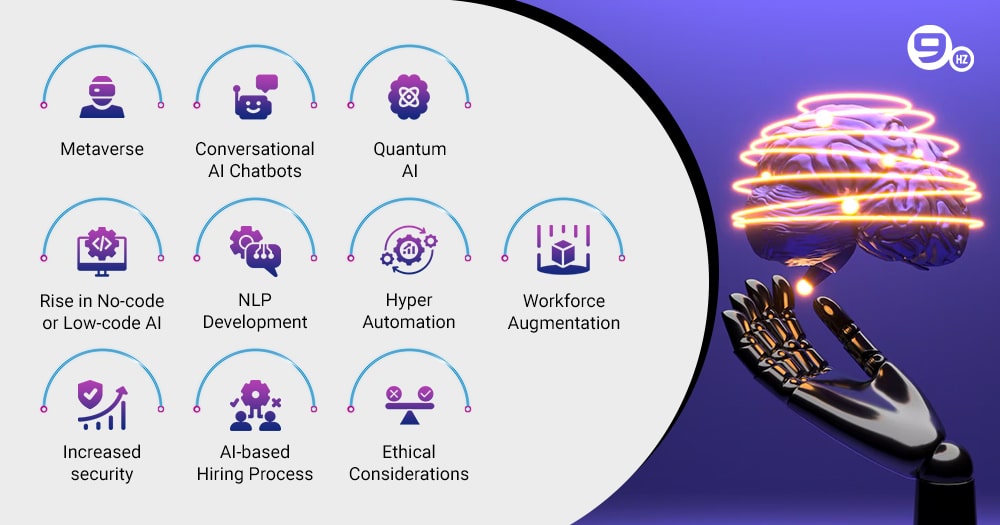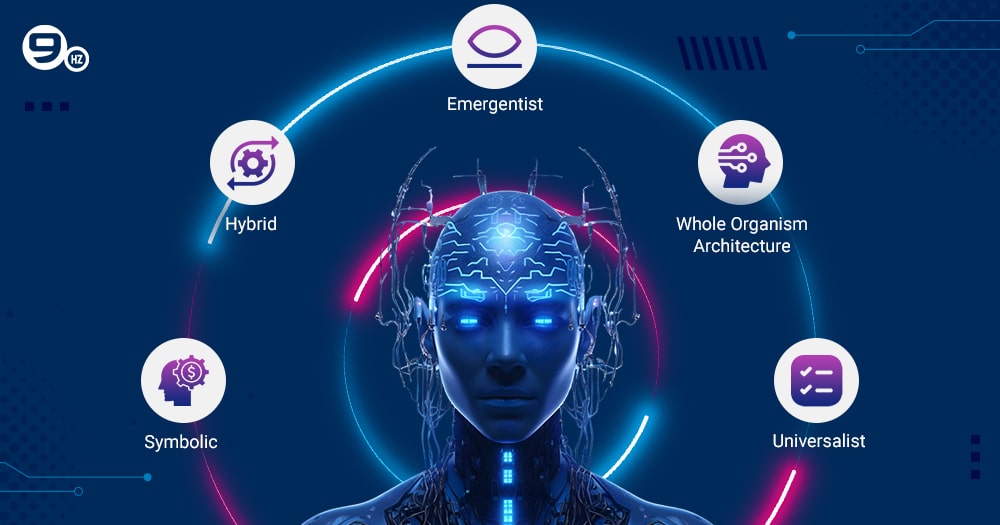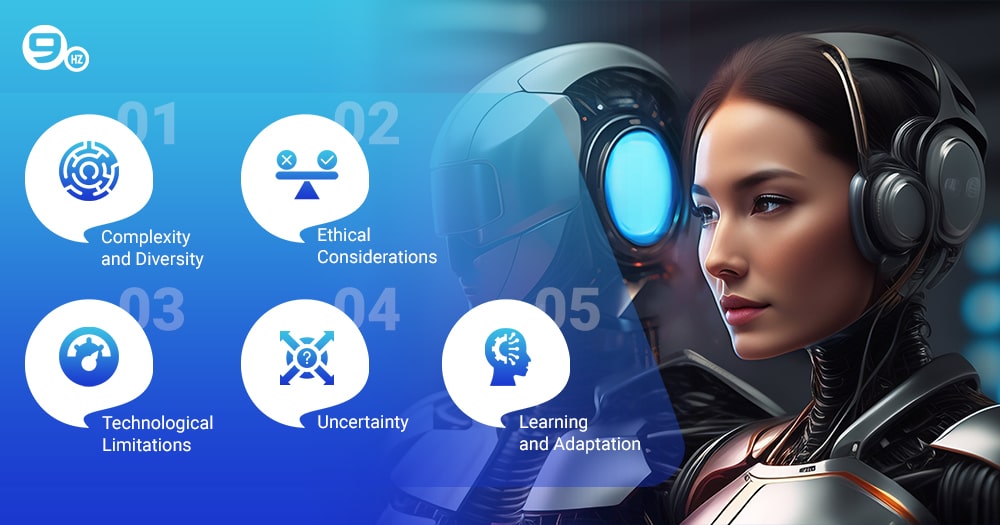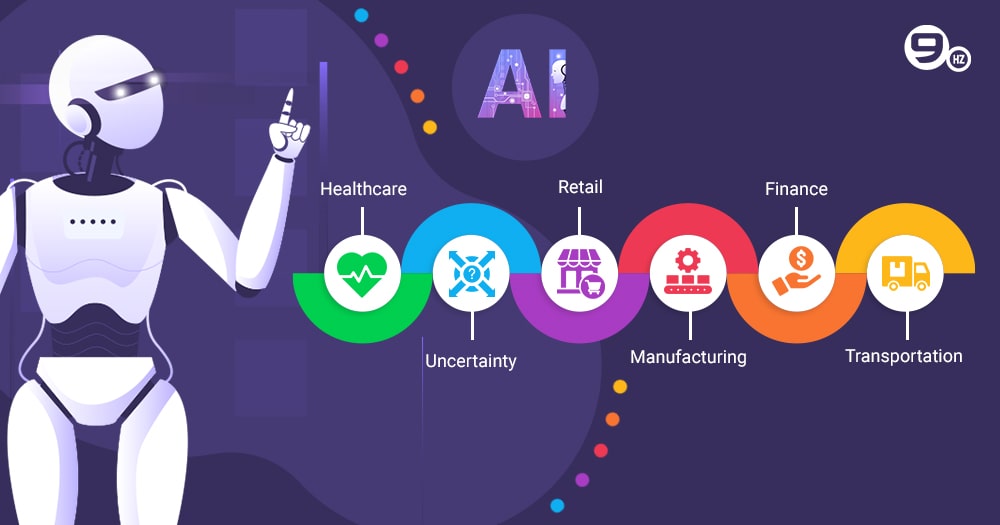Artificial Intelligence is a worldwide popular technology that is now revolutionizing the world. It was invented to turn basic computers into smart machines which can think like humans to solve any problem or automate human repetitive tasks. However, as the technology is growing rapidly, a new concept comes under AI i.e, Artificial General Intelligence (AGI).
It’s an advanced level of technology that allows machines to learn, think, and take action based on their own consciousness and data. The AGI is also known as Strong AI, which has human-like capabilities to do tasks that humans can do.
Did you know? The AGI market is expected to reach $27.49 billion by 2030. Whether it’s self-driving cars, military weapons, market analysis, or creating content, AGI proves its capabilities and rapidly adapts to today’s real world. However, many people are not aware of AGI and how it will impact the future. Don’t worry!
Here, we will discuss everything about AGI, its types, potential, benefits, use cases and impact. By the end of this guide, you’ll be aware of AGI and how Artificial Intelligence will change the future, and how it will shape the future of humanity. Let’s find out!
What is Artificial General Intelligence?
Artificial General Intelligence (AGI) is a type of AI that allows machines to match or even surpass human capabilities to do any task. It is popularly known as Strong AI. With the use of AGI, machines have the ability to think, learn, and act with their own self-understanding. Currently, it’s a theoretical concept, and AI hasn’t reached that level, but the researchers are working with a long-term vision to turn it into reality because it would be able to solve a variety of complex processes in different industries with its own capabilities.
Top 10 Current Trends and Future Prospects of AGI

The advancement of Artificial General Intelligence technology is growing rapidly, especially after COVID. As AGI is currently not the reality, some projects are close to working with AGI technology and can be helped to push AGI development. Here, we’ve handpicked some of the latest trends in AGI that are giving the future prospects of AGI that are giving the future prospects of AGI for any artificial intelligence development company:
1. Metaverse
When it comes to finding the AGI trends, Metaverse is the first example. It’s a virtual world where users can create their own character, build objects that are exact replicas of the real world, interact with others, do human-like activities, and have an immersive experience virtually. It all happens because of AGI technology, which allows us to generate realistic environments and objects in Metaverse and let virtual characters think, learn, and act accordingly.
2. Conversational AI Chatbots
Another best part of AGI’s potential is conversational AI chatbots. With the help of AGI technology, these AI chatbots have the ability to think, learn, and act with self-understanding. Whenever a visitor comes to a website, the AI Chatbot will ask for their queries, understand them clearly, give them the most personalized solution for their query, and ensure satisfaction. Soon, these AI Chatbots will revolutionize and be used in various sectors for different operations.
3. Quantum AI
Quantum AI has gained huge potential in recent years. It pushes the boundaries of AI and slowly reaches AGI technology. Quantum AI can analyze huge amounts of data from books, articles, blogs, and other sources on the internet and is able to handle obstacles like Artificial General Intelligence by thinking with its own ability and acting accordingly.
4. Rise in No-code or Low-code AI
Gone are the days when only well-experienced coders were in demand by IT companies. AI has heavily impacted this sector and has come up with AI-powered no-code or low-code environments for developers including those working in software development companies in the USA. Most of the development coding operations can be done by AI, and developers manage the program. So the demand has significantly changed from learning coding to learning AI platforms where codes can be done back-side, and developers can use drag-and-drop tools to develop web apps and software. As the technology grows, the culture of no-code will rise, and AGI-based platforms will do coding with their own ability and deliver similar or even higher results than humans. This shift has been facilitated by the emergence of the best AI apps designed to streamline development processes and empower developers with efficient tools.
5. NLP Development
Nowadays, NLP (Natural Language Processing) development is getting huge success. One such great example is OpenAI’s GPT-3. It’s an advanced NLP version which uses 175 billion parameters to process languages. Later, GPT-4 was released which used 100 trillion parameters to process language and come up with best results. NLP development makes machine interaction with humans much easier without any coding.
6. Hyper Automation
AI has impacted various sectors and jobs because now, these AI-based machines can automate repetitive tasks for humans. As the technology grows towards AGI, these machines are getting human-like capabilities to do many more tasks in different domains better than humans. Hyper automation is an advanced layer of AI that helps to automate various areas for organizations, and most businesses are adapting automation for rapid growth and scalability.
7. Workforce Augmentation
Previously, when computers were launched in the market, everyone feared that computers would replace humans. However, it creates more jobs for those who can use computers. Similarly, AI is not replacing jobs anymore; it creates tons of new jobs in an organization. Whether it’s sales, marketing, or customer support, AI machines automate repetitive tasks and create new job opportunities to let humans use these AI machines and increase productivity. In upcoming years, AI will grow towards AGI and make operations much easier.
8. Ethical Considerations
It clearly shows that AI has impacted almost every industry and is shaping the future. However, as AI technology grows with more advancements like the AGI system, it’s important for governments, corporations, and individuals to raise ethical considerations to reduce the maximum risk and benefit from it.
9. Increased security
Artificial General Intelligence systems allow machines to think, learn and act as per their understanding. Which gives a lot of benefits in the cybersecurity sector. AGI can help to enhance the security and allow machines to protect themselves if they find any malicious activity. So the dependency of human tracking is minimum and ensures all the data is protected all-time under Strong AI systems.
10. AI-based Hiring Process
When COVID hits, almost every organization uses online virtual platforms to do hiring. And after the rise of AI, companies are now planning to implement AI/ML technology in the hiring process to automate most of their operations and make hiring more efficient and smoother. Such as AI will help to sort out the right resume as companies job posts and save company’s time to make hiring easier.
The Evolution of AGI: From Concept to Reality
When we talk about Artificial General Intelligence (AGI), it’s not a recent idea. For centuries, many scientists and philosophers have shown interest in the idea of AGI. One such great name is Alan Turing, who envisioned machines that are capable of passing the Turing test.
It’s a benchmark to determine if a machine can show intelligence like a human. That’s where groundwork started to research if it’s possible to have human-like intelligence in machines. Today, a machine learning development company plays a crucial role in advancing this research, striving to create systems that emulate human cognitive abilities.
These formative years have shown the development of AI systems and showed the potential to adapt human-like intelligence in various domains like gaming and content generation. Generative AI development company initiatives have been instrumental in pushing the boundaries of these capabilities. Here’s the complete timeline breakdown to know the theoretical origins of AGI and its current state:
1950s: Foundational Neural Network Algorithms
In the 1950s, scientists started building computational models that tried to mimic similar human brain structures. These are known as neural networks. These models are considered the groundwork for the future of AGI by implementing human-like thinking in machines.
1960s-1970s: Deliberative Reasoning Hypotheses
At this point, scientists and researchers started working on creating systems which can make decisions like humans. They mainly aim to build a machine that formalizes human thinking but these systems aren’t able to match human-thinking while making decisions.
1980s-1990s: Mathematical General Intelligence Definitions
During the 1990s, scientists planned to develop complex mathematical formulas that could help machines describe what general intelligence looks like. These formulas are unable to translate into practical AI systems.
2000s-2010s: Engineering Specialized AI Capabilities
In the 2000s, this was the real beginning of AI when AI systems were implemented in various domains like gaming, image classification and data-based predictions. However, these systems can think logically but they have limited data and struggle with knowledge base.
2020s: Large Language Models
One of the biggest trends rolled out in the 2020s i.e, OpenAI GPT-3, which has the ability to learn, understand and generate human-like text as response and perform well in different languages. However, these AIs struggle to understand deep reasoning or emotions.
Ongoing: Pathways on Broad Capabilities
Now, the process of improving AGI is ongoing and researchers are exploring memory systems, hierarchical model structures, transformer architectures and multi-agent simulations that lead to advanced AGI systems. But expecting high-human intelligence is still a long-term vision and requires further breakthroughs.
What are the Types of AGI?

Many computer scientists and researchers are working on expanding the field of AGI. Here are some of the approaches used to create systems that reach the AGI level:
1. Symbolic
One of the simplest approaches to Artificial General Intelligence is symbolic. As per this approach, symbolic thinking involves symbols to represent any idea or concept as humans understand. When machines follow the symbolic approach, they can achieve similar level general intelligence like humans. Researchers said, the symbols approach can help AI machines to understand programming with clear and better logics.
2. Hybrid
Some researchers and scientists believe that machines can achieve human-like intelligence via a hybrid approach. Because a hybrid approach allows machines to work with various parts together to create something better. When various parts of machines work together then it can lead to developing AGI systems.
3. Emergentist
Emergentist is a similar approach that the human brain has where a set of elements (like Neurons) self-organize complexly in reaction to that experience of the body. Similarly, researchers believe that machines can follow a similar approach and emerge with human-like intelligence.
4. Universalist
As per the universalist approach, when basic fundamentals of mathematical principle are cleared then it reaches to general intelligence. So researchers believe that once these principles were cleared by machines theoretically then it can be applied by machines to create AGI systems. WIth the hope that machines will turn these theoretical knowledge into practical worlds with human intelligence.
5. Whole Organism Architecture
According to researchers and scientists, the whole organism architecture approach means that AGI is only achievable when AI systems learn from physical interactions. So, they believe that integrating AI models with physical representation of the human body can lead to the creation of AGI.
What is the Difference Between Artificial Intelligence and Artificial General Intelligence?
When it comes to finding the key difference between AGI and AI, then AGI is a subcategory of AI. However, there’s a lot more difference to know:
| Artificial Intelligence | Artificial General Intelligence |
|---|---|
| AI allows machines to focus on a particular or limited set of tasks based on given data and instructions | AGI mimics human-like intelligence to think, learn, and act with self-understanding without giving prior instructions and data |
| AI uses pre-given data to analyze it and take any action or make predictions | AGI act like humans to think and learn through different experiences |
| AI lacks artificial consciousness or cognitive abilities | AGI has human-like intelligence and cognitive abilities |
| AI is not capable of making independent decisions beyond the assigned tasks | AGI is capable of making independent decisions without human intervention |
| AI can’t transfer knowledge from one area to another area or tasks | AGI is capable of transferring knowledge from one domain to another domain |
Artificial Intelligence (AI) is a field of computer science that can make computers capable of doing complex operations and solving problems similar to or better than humans. One of the best examples of using AI is ChatGPT, which has shaken the world with its capabilities to generate human-like text. AI mainly works based on the data provided, so whatever the data is stored based on, it analyzes and takes action.
On the other hand, Artificial General Intelligence is a conceptual but advanced version of AI where it allows machines to learn, think, and take action based on self-understanding. This means that machines don’t need to rely on stored data because the AGI system can do any task, collect data from it, and take better action. AGI is open to learning and taking action in different industries and making machines similar to human intelligence. Some researchers and scientists believe that AGI is going to change the world with its advanced technologies and make machines capable of thinking like humans.
The main difference between AI and AGI can be seen in their scope of capabilities and level of generalization. As per comparison, AI is categorized into two main parts: strong AI and weak AI.
Strong AI: Strong AI is referred to as AGI, which makes machines capable of doing tasks that humans can do in a wide range of domains. It makes machines capable of thinking, learning, and taking action accordingly with self-understanding and solving problems without giving prior data and training.
Weak AI: Weak AI is also referred to as Narrow AI, which is specially designed to do any specific task within a limited domain, such as image recognition, language translation, or playing chess.
Five Major Challenges of AGI

Here are five common challenges of AGI:
1. Complexity and Diversity
One of the biggest challenges that AGI faces is complexity and diversity. AGI systems should be capable of understanding the challenges and variabilities in the real-world. These AGI machines are expected to think like human intelligence or even better. For example – a human can easily differentiate between sarcasm and seriousness in tone. But for AI, it’s a challenge to identify. And such abilities for machines to identify like humans required advanced technical development.
2. Ethical Considerations
Another challenge that faces during AGI development is ethical consideration. As AGI follows humans-like thinking to solve real-world problems, various ethical issues can arise such as privacy, autonomy and control of technology.
3. Technological Limitations
There are various technological barriers that can arise during AGI research such as scalability, interpretability and robustness. In order to overcome these challenges, required collaboration, algorithmic approaches and advanced hardware infrastructure.
4. Uncertainty
Another common challenge that can be faced during AGI development is uncertainty. Humans are capable of dealing with uncertainty, but machines with human-like thinking can face uncertainty when the data is limited or not available to process and implement.
5. Learning and Adaptation
The AGI system required continuous new information to learn and implement in the real-world. And that’s a complex task to handle for current AI systems.
Opportunities in AGI Development
Every coin has two sides; if AGI comes with so many challenges, then there are various opportunities also available with AGI. One of the biggest opportunities that AGI has is to transform many industries. It can automate various tasks, enhance productivity, and develop new products that current AI systems are not capable of. AGI systems are similar to or better than human intelligence, which means they can solve some of the world’s biggest problems that humans can’t solve, such as climate change, poverty, and various diseases.
Bridging the Gap Between Artificial and Human Intelligence
AGI is a concept that comes to bridge the gap between artificial and human intelligence. It’s an advanced technology that can make machines capable of thinking, learning and making decisions like humans with their self understanding even when there’s limited information available. In order to achieve AGI, researchers are focusing on advancement in neural networks, ML and natural language processing.
Impact of AGI on Various Industries

Here are some top industries where AGI has impacted heavily:
1. Healthcare
AGI has a huge potential to transform the healthcare sector. Whether it’s improving diagnostics, patient care, or personalized treatment, AGI systems are capable of making machines more advanced to analyze data, learn from the information, and come up with more accurate and personalized treatment plans for patients. When healthcare machines utilize the power of AGI, the results will be much more accurate and insightful, accelerating the overall healthcare operations.
2. Retail
Another industry which has been impacted by AGI is Retail. Where machines can utilize AGI to analyze customer data and provide highly tailored solutions regarding the inventory management, logistics, shipping and customer demands. With AGI optimization, the retail businesses are getting insightful reports to make their overall supply chain efficient and better by reducing risk and cost.
3. Finance
AGI has the capability to revolutionize the finance sector. It can help to identify risks, detect frauds, and provide personalized solutions by analyzing vast amounts of data. AGI systems can analyze data, learn from it and come up with personalized solutions and identify challenges to resolve.
4. Manufacturing
In order to improve the order fulfillment operations, quality, demand, cost and maintenance, AGI system can be helpful in manufacturing. These systems can analyze the factory data, learn from it and provide best possible strategies for intelligent production systems which allow it to run the operations efficiently and cost-effectively.
5. Education
AGI systems can help to enhance the learning experience of students by providing personalized tutoring experience. It can analyze each student’s performance data and based on its performance, habit, level of learning, it will provide a personalized learning plan which can help each student to learn more efficiently. There are various other tasks that can be automated with the AGI system and let teachers focus mainly on teaching effectively.
6. Transportation
Another big industry in which AGI is contributing positively is transportation. AGI systems are capable of analyzing the real-time traffic data, learn from it and come up with optimal route suggestions for reducing cost and travel time. It is capable of revolutionizing the travel industry by providing various optimized modes of transportation and enhancing the infrastructure.
The Role of AGI in Shaping the Future of Humanity
If we talk about the role of Artificial General Intelligence (AGI) in shaping the future, then it has a huge potential to change in a wide range of domains. AGI is capable of making machines that can think, learn, and act with their self-understanding, just like human intelligence, which opens new possibilities and opportunities in different industries. Whether it’s healthcare, transportation, education, finance, or manufacturing, AGI can learn from the data and come up with new discoveries that may not be possible for human intelligence to discover.
FAQ’s: Artificial General Intelligence
Q.1 How Far Away are We From AGI?
Many researchers and experts are still in debate about the timeline to achieve artificial general intelligence (AGI). Some believe that it can be achieved in years or decades and some think it takes centuries or longer.
Q.2 What is an AGI vs AI?
Artificial general intelligence (AGI) is a subcategory of Artificial Intelligence that makes machines capable of thinking like humans and act with self understanding.
Q.3 Will AI Take Over Humanity?
AI will not take over humanity. It’s just a technology that will grow over time and make operations easier and more efficient in a wide range of industries.
Q.4 What are Some Examples of Artificial General Intelligence?
Some best examples of AGI are self-driving cars, Conversational AI chatbots, Voice assistants, autonomous drones and many more.
Q.5 Can AI Read your Mind?
Yes, AI can read your mind by interpreting brain signals. By combining deep learning algorithms and large language models, it can analyze the brain and identify what a person is thinking. It can also record brain activity through a scale and turn these brainwaves into written text.





